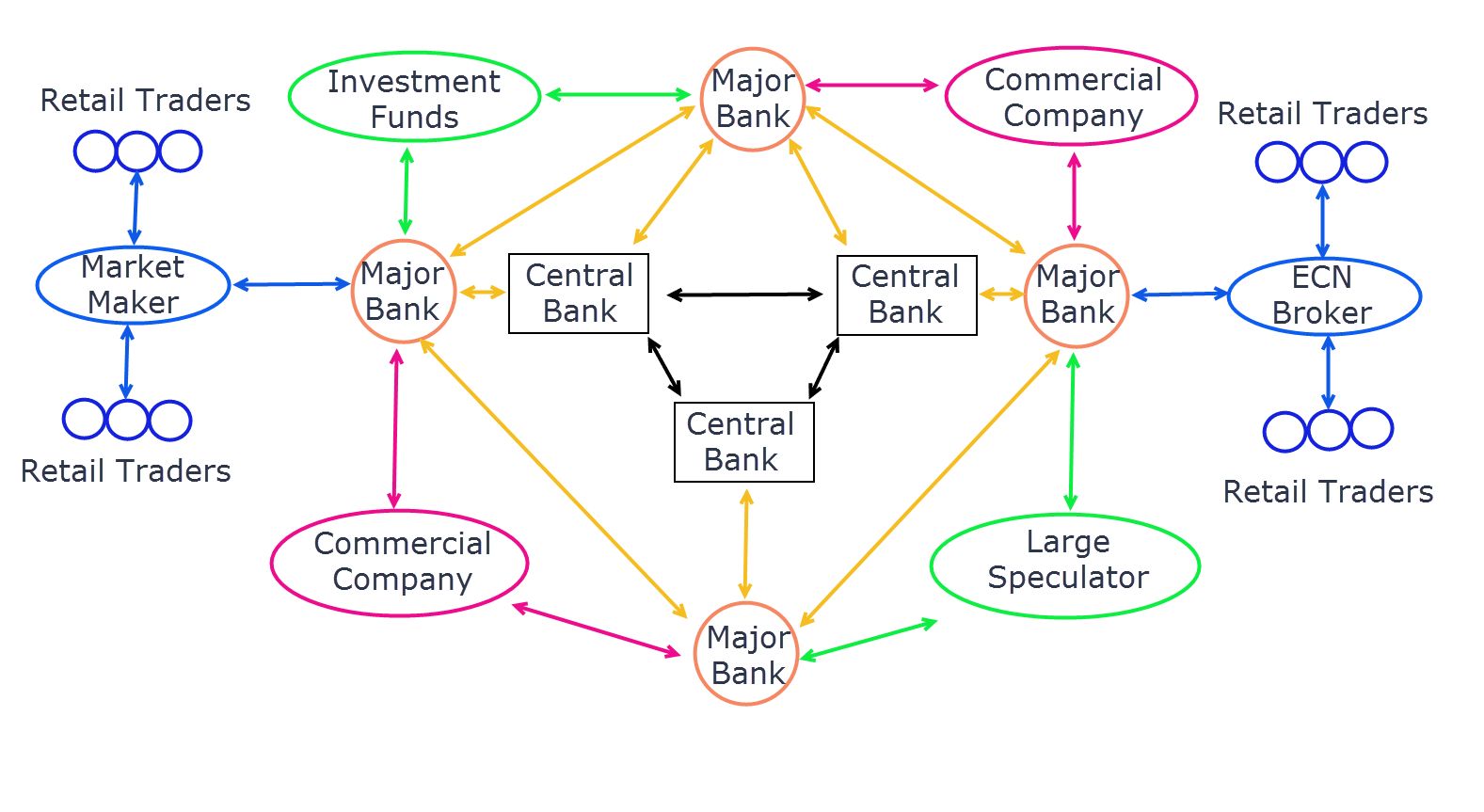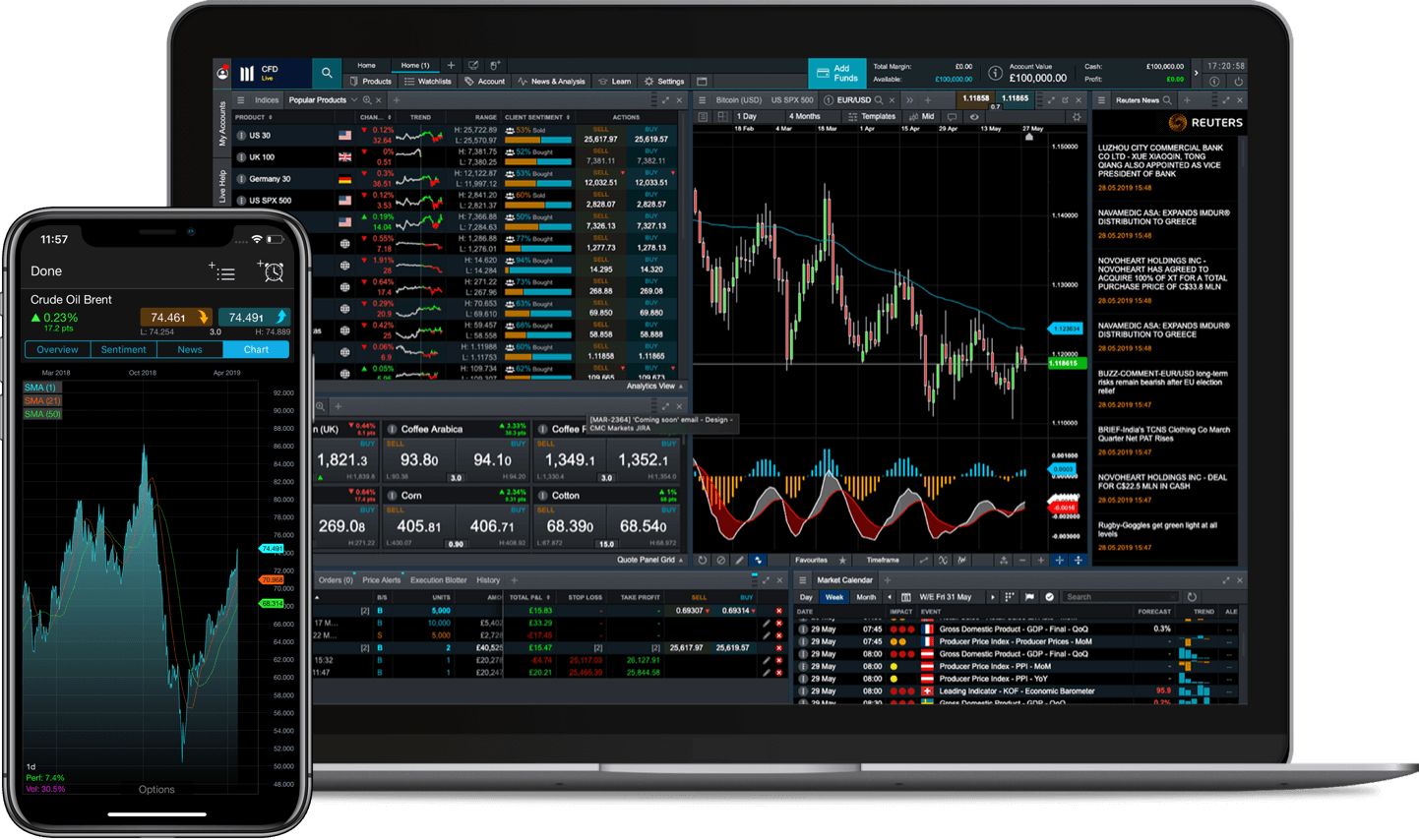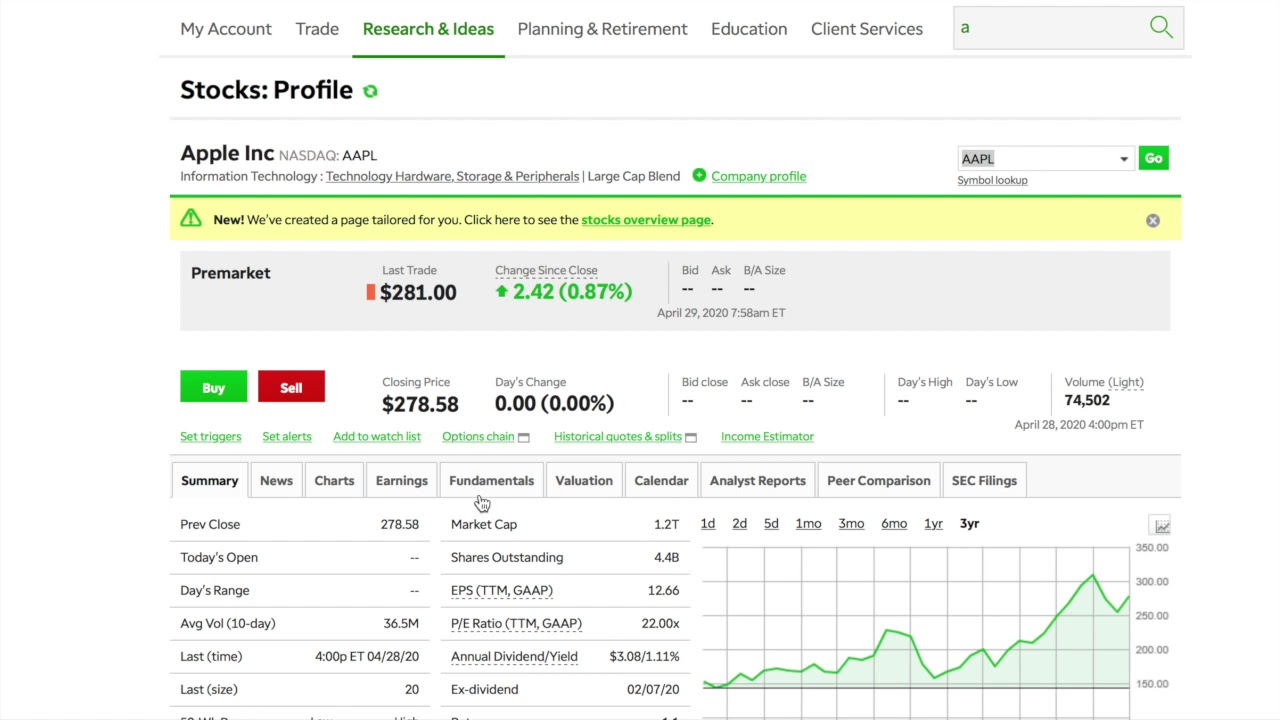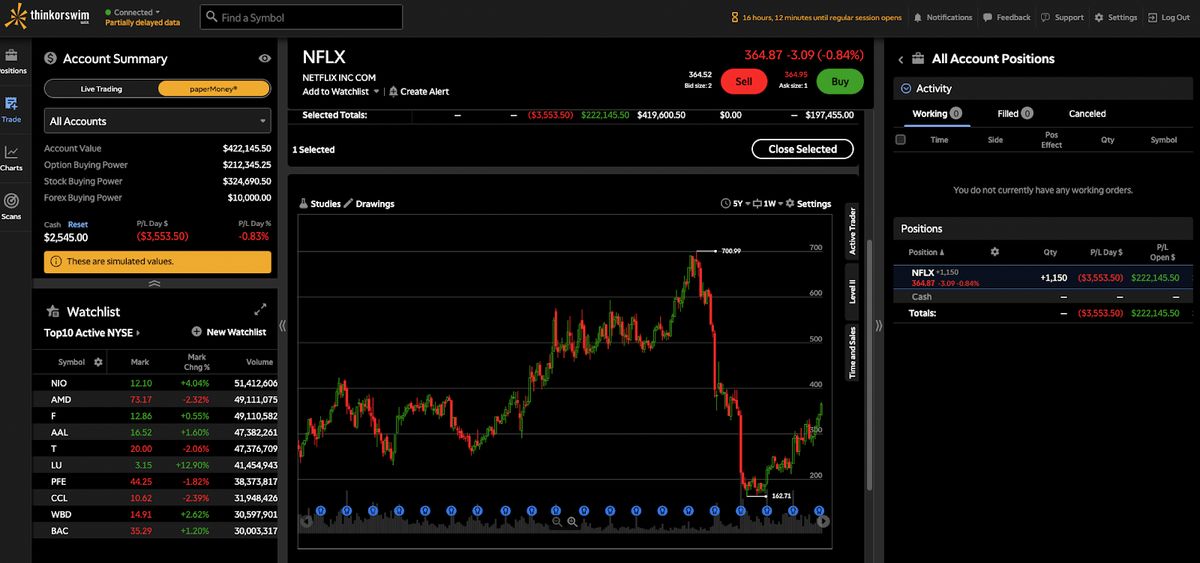Introduction
Welcome to the exciting world of options trading! If you’re looking to expand your knowledge and delve into the world of investing, learning options trading can open up a whole new realm of possibilities. Options trading allows individuals to speculate on the future price movement of various underlying assets, from stocks and bonds to commodities and currencies.
Options provide traders with the flexibility to profit from both rising and falling markets. By understanding how options work and employing strategic trading techniques, you can potentially maximize your gains and protect against losses.
In this article, we will explore the basic concepts of options trading, discuss the different types of options available, delve into the option pricing model, and highlight common strategies used by options traders. Additionally, we will provide guidance on selecting the right broker, managing risks, developing a trading plan, and utilizing technical analysis and key indicators.
Whether you’re a beginner in the world of investing or an experienced trader looking to expand your horizons, mastering options trading can significantly enhance your investment portfolio and potentially yield substantial returns. However, it is vital to approach options trading with caution and acquire the necessary knowledge and skills to make informed decisions. This article aims to serve as a comprehensive guide to help you navigate the world of options trading and make confident, well-informed investment choices.
So, buckle up and get ready to explore the exciting and potentially profitable world of options trading. By the end of this article, you’ll have a solid foundation to start your journey towards becoming a successful options trader. Let’s dive in!
What are options?
Options are financial derivatives that give traders the right, but not the obligation, to buy or sell an underlying asset at a predetermined price, known as the strike price, for a specific period of time. These underlying assets can include stocks, bonds, commodities, currencies, or even indices.
There are two types of options: call options and put options. Call options give traders the right to buy the underlying asset at the strike price, while put options give traders the right to sell the underlying asset at the strike price.
Options provide traders with leverage, allowing them to control a larger amount of the underlying asset with a relatively small investment upfront, known as the premium. The premium is the price that traders pay to acquire the option contract.
One key distinction in options trading is the expiration date. Options contracts have a specific expiration date, after which they become void. This means that traders must exercise their options or close their positions before the expiration date to realize any potential profits.
Options can be used for various purposes in the financial markets. Some traders use options as a form of hedging strategy to protect their investments against adverse price movements. Others utilize options for speculative purposes, aiming to profit from the anticipated price fluctuations in the underlying asset.
It’s important to note that options trading involves risks and requires a thorough understanding of the underlying asset, market conditions, and trading techniques. To succeed in options trading, traders must conduct thorough research, analyze market trends, and develop a well-defined trading plan.
In the next section, we will discuss the reasons why you should learn options trading and the potential benefits it can offer to your investment journey. Let’s explore this fascinating world further!
Why should you learn options trading?
Options trading offers a range of benefits and reasons why you should consider diving into this exciting field:
1. Potential for higher returns: Unlike traditional stock trading, options trading allows you to profit from both rising and falling markets. With proper strategizing and risk management, you have the potential to generate higher returns compared to other investment avenues.
2. Flexibility and versatility: Options provide a wide array of trading strategies that can be tailored to your risk tolerance and financial goals. Whether you prefer conservative approaches like covered calls or more aggressive strategies like buying long puts, options trading offers the flexibility to adapt to different market conditions.
3. Hedging and risk management: Options can be utilized as a powerful tool for hedging and managing risks associated with your portfolio. By employing options as a form of insurance, you can protect your investments against adverse price movements and limit potential losses.
4. Leverage: Options allow you to control a larger amount of the underlying asset with a relatively smaller investment upfront. This leverage amplifies your potential returns, making options an attractive choice for traders looking to maximize their gains.
5. Diversification: Options trading provides a means to diversify your investment portfolio. By including options in your trading strategies, you can access a broader range of assets and potentially reduce the overall risk of your portfolio.
6. Trading opportunities in all market conditions: Whether the market is bullish, bearish, or range-bound, options can offer numerous opportunities to profit. By utilizing various strategies, such as buying calls during an uptrend or selling puts during a sideways market, you can capitalize on different market scenarios.
7. Intellectual challenge: Options trading can be intellectually stimulating and rewarding. It requires in-depth analysis, strategic thinking, and constant learning to navigate the complexities of the options market. Engaging in options trading can help enhance your analytical abilities and sharpen your decision-making skills.
8. Potential for additional income: For those looking to generate additional income, options trading can be a viable option. Strategies such as selling covered calls or cash-secured puts can provide a steady stream of premium income, which can supplement your overall investment returns.
9. Access to a global market: Options trading allows you to gain exposure to various global markets and assets, including stocks, commodities, and currencies. This global reach opens up a world of trading opportunities and allows you to diversify your investments across different regions and industries.
Whether you’re a seasoned investor or just starting, learning options trading can significantly expand your investment arsenal and provide you with the tools to navigate the ever-changing financial landscape. The next section will introduce you to the basic concepts of options trading, providing you with a solid foundation to build upon.
Basic concepts of options trading
Before diving into options trading, it’s essential to understand some fundamental concepts that form the building blocks of this market:
1. Call options and put options: As mentioned earlier, there are two types of options: call options and put options. Call options give the holder the right to buy the underlying asset at the strike price, while put options give the holder the right to sell the underlying asset at the strike price.
2. Strike price: The strike price, also known as the exercise price, is the price at which the underlying asset can be bought or sold when exercising the option. It is agreed upon when the option contract is created and remains fixed throughout the life of the contract.
3. Expiration date: Options have a specific expiration date after which they become invalid. Traders must exercise their options or close their positions before the expiration date. The expiration date impacts the pricing and time value of the options.
4. Premium: The premium is the price paid to acquire an options contract. It represents the value of the option and is determined by factors such as the underlying asset’s price, volatility, time to expiration, and prevailing market conditions.
5. In-the-money, out-of-the-money, and at-the-money: These terms describe the relation between the strike price and the current price of the underlying asset. An option is considered in-the-money if exercising it would result in a profit. An option is out-of-the-money if exercising it would lead to a loss. An option is at-the-money if the strike price is equal to the current market price of the underlying asset.
6. Time decay: Options have a finite lifespan, and as time passes, the value of the option decreases. This is known as time decay. The rate of time decay accelerates as the expiration date approaches, making it important for options traders to consider the impact of time on their positions.
7. Volatility: Volatility refers to the magnitude of price fluctuations in the underlying asset. High-volatility assets have larger price swings, which generally leads to higher option premiums. Options traders often assess volatility to determine the potential profitability of their positions.
8. Options series and chains: Each underlying asset typically has multiple options available, known as options series. These series consist of options with different strike prices and expiration dates. An options chain provides a visual representation of all available options for a particular underlying asset.
Understanding these basic concepts lays the foundation for navigating the intricate world of options trading. In the next section, we will explore the different types of options available and how their characteristics can impact trading strategies. Let’s continue our journey into the world of options!
Different types of options
Options trading offers a variety of contract types, each with its own unique characteristics. Understanding the different types of options will help you tailor your trading strategies to your specific investment goals and market conditions. Let’s explore the most common types:
1. American options: American options can be exercised at any time before the expiration date. This provides flexibility for traders to exercise their options and capture potential profits whenever they deem it favorable.
2. European options: European options, on the other hand, can only be exercised at the expiration date. Traders can’t exercise European options before the predetermined date, which means their value depends solely on the price of the underlying asset at expiration.
3. Vanilla options: Vanilla options are the most basic type of options. They have standardized terms, including a fixed strike price, expiration date, and contract size. Vanilla options can be both call options and put options and are commonly traded on exchanges. They serve as the foundation for more complex options strategies.
4. Exotic options: Exotic options have more complex payout structures and additional features compared to vanilla options. These options can have variations in exercise styles, such as Bermuda options (which can be exercised at specified times) or barrier options (which have certain price barriers that can trigger the option). Exotic options provide traders with more customized choices but may require advanced knowledge to understand and trade effectively.
5. Binary options: Binary options have gained popularity in recent years. With binary options, traders speculate on whether the price of the underlying asset will be above or below a predetermined level at a specific time. Binary options have a fixed payout if the predicted condition is met, but they also have a higher level of risk compared to other types of options.
6. LEAPS (Long-Term Equity Anticipation Securities): LEAPS are options with longer expiration dates, typically extending up to three years or more. They allow traders to take long-term positions and benefit from the price movement of the underlying asset over an extended period.
Understanding the characteristics of each type of option is crucial for constructing effective trading strategies. It’s important to analyze market conditions and the specific requirements of your trading plan before selecting the most suitable option type.
In the next section, we will delve into the option pricing model, which plays a vital role in determining the value of options and can help traders make informed trading decisions. Let’s continue our exploration of options trading!
Understanding the option pricing model
The option pricing model is a mathematical formula used to estimate the fair value of an option. It takes into account various factors that influence an option’s price, allowing traders to make informed decisions about buying or selling options. The most widely used option pricing model is the Black-Scholes model, developed by economists Fischer Black and Myron Scholes.
The Black-Scholes model considers several key components in determining option prices:
1. Underlying asset price: The current price of the underlying asset is a crucial factor in determining the value of an option. As the price of the underlying asset fluctuates, it directly impacts the intrinsic value of the option.
2. Strike price: The strike price is another significant factor influencing option prices. The relationship between the strike price and the current price of the underlying asset determines whether an option is in-the-money, at-the-money, or out-of-the-money. In-the-money options generally have higher premiums compared to at-the-money or out-of-the-money options.
3. Time to expiration: The time remaining until the option’s expiration date affects the option’s value. As the expiration date approaches, the time value of the option diminishes due to time decay. Options with more time to expiration generally have higher premiums.
4. Volatility: Volatility measures the magnitude of price fluctuations in the underlying asset. Higher volatility leads to larger potential price swings, increasing the probability of the option ending up in-the-money. As a result, options on highly volatile assets tend to have higher prices.
5. Interest rates: Interest rates can also impact option prices. Higher interest rates typically increase the cost of carrying the underlying asset, which is factored into the option pricing calculation.
6. Dividends: For options on dividend-paying stocks, dividends can influence option prices. When a dividend is expected during the option’s life, it can reduce the option’s value, as the stock price typically decreases by the dividend amount on the ex-dividend date.
By considering these variables and applying mathematical formulas, the option pricing model estimates the fair value of an option. This fair value represents the theoretical price at which the option should trade in the market under ideal conditions.
Traders can compare the fair value to the market price of an option to assess if it is overpriced or underpriced. This analysis helps identify potential trading opportunities – buying options that are undervalued or selling options that are overvalued.
It’s important to note that the option pricing model provides an estimate, and actual market prices can deviate due to various factors such as supply and demand dynamics and market sentiment.
Now that we understand the option pricing model, let’s explore some common strategies used in options trading. These strategies can be employed to maximize profit potential and minimize risk in the options market. Let’s continue our journey into the world of options trading!
Common strategies in options trading
Options trading offers a wide range of strategies that traders use to achieve their financial goals and manage risk. Understanding these strategies is crucial for success in the options market. Let’s explore some of the most commonly employed strategies:
1. Covered call: The covered call strategy involves selling a call option on an underlying asset that you already own. By selling the call option, you generate income from the premium received. If the option is exercised, you are obligated to sell the underlying asset at the strike price. This strategy is often used when traders have a neutral or slightly bullish outlook on the underlying asset.
2. Protective put: The protective put strategy involves buying a put option on an underlying asset you own. This gives you the right to sell the asset at the strike price, providing downside protection in case the value of the asset declines. The put option acts as insurance, limiting potential losses in case the market moves against your position.
3. Long straddle: In a long straddle, traders buy both a call option and a put option with the same strike price and expiration date. This strategy is employed when there is an expectation of significant price volatility. If the price moves significantly in either direction, the trader can make a profit. The risk in this strategy is limited to the premium paid for both options.
4. Bull spread: Bull spread strategies involve buying a call option with a lower strike price and selling a call option with a higher strike price. This strategy is used when traders have a moderately bullish outlook on the market. The premium received from selling the higher strike call offsets the cost of buying the lower strike call, limiting the overall risk for the trader.
5. Bear spread: Bear spread strategies are the opposite of bull spreads. Traders buy a put option with a higher strike price and sell a put option with a lower strike price. This strategy is employed when traders have a moderately bearish outlook on the market. The premium received from selling the lower strike put helps offset the cost of buying the higher strike put, reducing the overall risk of the trade.
6. Butterfly spread: The butterfly spread strategy involves combining multiple options with the same expiration date but different strike prices. This strategy aims to capitalize on a specific range-bound scenario where the underlying asset’s price remains close to the middle strike price. The risk in this strategy is limited to the premium paid, but the potential profit is also limited.
7. Strangle: A strangle strategy involves buying both a call option and a put option with different strike prices, but both options have the same expiration date. This strategy is used when traders expect significant price volatility but are unsure about the direction. The goal is to profit from a large price movement in either direction. The risk in this strategy is limited to the premium paid for both options.
These are just a few examples of the many strategies available in options trading. Each strategy has its own risk-reward profile and is suited to different market conditions. It’s important to thoroughly understand the characteristics and potential outcomes of each strategy before implementing them in your trading activity.
Now that we’ve explored common options trading strategies, let’s discuss how to choose the right broker for options trading. Selecting a reputable and reliable broker is crucial for a successful trading journey. Let’s proceed to the next section!
How to choose the right broker for options trading
Choosing the right broker is a critical decision when it comes to options trading. The broker you select will have a significant impact on your trading experience, access to markets, and the tools available to you. Here are some important factors to consider when choosing a broker for options trading:
1. Regulation and reputation: Ensure that the broker you choose is regulated by a credible financial authority. Regulatory compliance helps ensure the broker adheres to certain standards and provides a level of protection for traders. Research the broker’s reputation and read reviews from other traders to gauge their reliability and trustworthiness.
2. Trading platform: A user-friendly and intuitive trading platform is essential for efficient options trading. The platform should provide real-time quotes, charting tools, and order execution capabilities. Test out the platform’s features and ensure it meets your requirements before opening an account.
3. Option contracts availability: Check if the broker offers a wide range of option contracts on various underlying assets. Having access to a diverse selection of options allows you to implement different strategies and take advantage of market opportunities.
4. Commissions and fees: Different brokers have varying fee structures, including commission charges, options contract fees, and any other additional charges. Compare the fee structures of different brokers to find one that aligns with your trading style and budget.
5. Educational resources and research tools: Look for a broker that offers educational materials, tutorials, webinars, and other resources to help you enhance your knowledge and understanding of options trading. Additionally, research tools such as market analysis, economic calendars, and options screeners can provide valuable insights for making informed trading decisions.
6. Customer support: Prompt and reliable customer support is important, especially if you encounter any technical issues or have questions about your trading activity. Research the broker’s customer service reputation and ensure they offer multiple channels for support, such as phone, email, and live chat.
7. Account types and minimum deposit: Consider the different types of accounts offered by the broker, such as individual accounts, joint accounts, or managed accounts. Also, check the minimum deposit requirements and assess whether it aligns with your investment budget.
8. Risk management tools: Look for brokers that provide risk management tools such as stop-loss orders, limit orders, and trailing stop orders. These tools can help you manage your risks effectively and protect your investment capital.
9. Mobile trading: If you prefer to trade on the go, ensure that the broker offers a mobile trading app that is compatible with your device. A mobile trading app provides flexibility and allows you to monitor your positions and execute trades from anywhere.
Remember that choosing the right broker is a personal decision, and what works for one trader may not be suitable for another. Take your time to research and compare different brokers, considering your trading goals, preferences, and the features that are most important to you.
Now that you’re equipped with the knowledge to choose a broker, let’s explore the crucial topic of risk management in options trading. Effective risk management is essential to protect your capital and minimize potential losses. Let’s move on to the next section!
Risk management in options trading
Risk management is a crucial aspect of options trading that helps protect your capital and minimize potential losses. By implementing effective risk management strategies, you can navigate the volatile nature of the options market with more confidence. Here are some essential risk management techniques to consider:
1. Determine risk tolerance: Before entering any trade, it’s important to assess your risk tolerance. This involves understanding how much capital you’re willing to risk on each trade and how much loss you can comfortably handle. Establishing risk parameters helps you make informed decisions and avoid excessive exposure.
2. Position sizing: Proper position sizing is key to managing risk. Allocate a portion of your account capital to each trade based on your risk tolerance and the size of the trade. Avoid risking a significant portion of your account on a single trade, as it can lead to substantial losses if the trade goes against you.
3. Set stop-loss orders: A stop-loss order is a predetermined point at which you will exit a trade to limit your losses. Set a stop-loss level based on your analysis and risk tolerance, and stick to it. This helps prevent emotional decision-making and ensures that you exit a losing trade before losses accumulate excessively.
4. Use limit orders: Placing limit orders helps you control the price at which you enter or exit a trade. By setting a limit order, you have more control over the execution price and can potentially avoid unfavorable fills. Additionally, limit orders can prevent slippage during volatile market conditions.
5. Diversify your portfolio: Diversification is a risk management technique that involves spreading your capital across multiple assets or markets. By diversifying your options trades, you reduce the impact of any single trade on your overall portfolio. This helps mitigate the risk of significant losses due to unexpected market events in a particular asset or sector.
6. Regularly monitor your positions: Keep a close eye on your open positions and monitor market conditions that may impact them. Stay informed about news, economic events, and corporate announcements that could potentially affect the underlying assets. Regular monitoring allows you to make timely adjustments or take necessary actions to manage risk effectively.
7. Continuously educate yourself: Investing time in learning and expanding your knowledge about options trading is an essential part of risk management. Stay updated with market trends, trading strategies, and risk mitigation techniques. By continuously educating yourself, you can make more informed decisions and adapt to changing market conditions.
Remember, while risk management techniques can help mitigate potential losses, options trading inherently carries risks. It’s crucial to only trade with risk capital – money you can afford to lose without jeopardizing your financial well-being. Consider working with a financial advisor or mentor who can provide guidance and help you formulate a risk management plan that suits your specific trading goals.
Now that we’ve covered risk management, let’s discuss the importance of developing a trading plan for options. A well-defined trading plan can help guide your actions and improve your overall trading performance. Let’s move on to the next section!
Developing a trading plan for options
Having a well-defined trading plan is essential for success in options trading. A trading plan acts as a roadmap, guiding your trading decisions and helping you stay disciplined in the face of market fluctuations. Here are the key elements to consider when developing a trading plan for options:
1. Define your trading goals: Start by identifying your trading goals and objectives. Are you looking for short-term profits or long-term wealth accumulation? Do you want to generate income or speculate on market movements? Defining your goals will help shape the strategies you employ and the risk levels you’re comfortable with.
2. Determine your risk tolerance: Assess your risk tolerance and be honest with yourself about how much risk you can comfortably handle. This will guide your position sizing, trade selection, and risk management techniques. Avoid taking on excessive risk that can negatively impact your overall financial well-being.
3. Select your preferred strategies: Choose the options trading strategies that align with your goals, risk tolerance, and market outlook. Research and familiarize yourself with different strategies such as covered calls, protective puts, spreads, or straddles. Each strategy has its own risk-reward profile, so select the ones that suit your trading style and objectives.
4. Set entry and exit criteria: Determine the criteria for entering and exiting trades. This includes identifying key technical or fundamental indicators that signal entry points and defining stop-loss levels or profit targets. Having clear entry and exit criteria helps you stay disciplined and avoid making emotional decisions based on short-term market fluctuations.
5. Implement risk management strategies: Integrate risk management techniques into your trading plan. This includes setting stop-loss orders, position sizing guidelines, and diversifying your portfolio. By incorporating risk management strategies into your plan, you protect your capital and minimize the impact of potential losses.
6. Keep a trading journal: Maintain a trading journal to track your trades and analyze your performance. Record the details of each trade, including entry and exit prices, reasons for entering the trade, and your thoughts and emotions throughout the process. Regularly reviewing your trading journal can help you identify patterns, strengths, and areas for improvement.
7. Continuously monitor and review your plan: The options market is dynamic, and market conditions can change rapidly. Regularly monitor your trading plan and review it to ensure it remains aligned with your goals and objectives. Make adjustments as necessary to adapt to changing market conditions or to refine your strategies based on your trading experience.
8. Stay disciplined: Stick to your trading plan and remain disciplined in your approach. Avoid succumbing to emotional reactions or impulsive decisions. Remember that successful trading is about consistency and following a predefined plan, even during periods of market volatility or uncertainty.
Developing a trading plan is a continuous process that requires ongoing evaluation and adjustment. As you gain experience and market knowledge, refine your plan to reflect your evolving trading style and goals. With a solid trading plan in place, you can approach options trading with confidence and improve your chances of long-term success.
Next, let’s explore how technical analysis can be applied to options trading. Technical analysis provides insights into market trends and potential price movements, helping you make more informed trading decisions. Let’s move on to the next section!
Technical analysis for options trading
Technical analysis is a method used in options trading to study and predict future price movements based on historical data and market trends. By analyzing patterns, charts, and indicators, technical analysis helps traders make informed trading decisions. Here are some key components of technical analysis for options trading:
1. Price patterns: Chart patterns, such as support and resistance levels, trend lines, and reversal patterns, can provide insights into market sentiment and potential price movements. Traders analyze these patterns to identify entry and exit points for their options trades.
2. Moving averages: Moving averages are commonly used indicators that smooth out price data to identify trends. Traders often look for convergence or divergence of moving averages to confirm market direction and potential entry or exit points.
3. Oscillators: Oscillators, such as the Relative Strength Index (RSI) or Stochastic oscillator, indicate overbought or oversold conditions in the market. Traders use these indicators to assess potential reversals or price corrections, which can signal opportunities for options trading.
4. Volume analysis: Volume is an essential component in technical analysis as it provides insights into the strength of price movements. High volume during price increases suggests positive market sentiment, while high volume during price declines can indicate selling pressure or negative market sentiment.
5. Fibonacci retracements: Fibonacci retracements are based on a sequence of numbers where each number is the sum of the two preceding numbers. These levels are often used to identify potential support and resistance areas in the market, helping traders determine price targets and entry points.
6. Candlestick patterns: Candlestick charts display the open, high, low, and close prices for each period. Traders analyze various candlestick patterns, such as doji, engulfing, or hammer patterns, to discern potential reversals or continuation signals in the market.
7. Trend analysis: Assessing the direction of the overall trend is a key focus of technical analysis. Traders identify uptrends, downtrends, or sideways trends and adjust their options trading strategies accordingly. Trend analysis can help determine the appropriate options buying or selling strategies.
Technical analysis is a tool, and it’s important to remember that no analysis method can guarantee accurate predictions in the market. Therefore, it’s advisable to combine technical analysis with fundamental analysis and market news to gain a holistic view of the options market.
Utilizing technical analysis can enhance your decision-making process and provide you with a framework for identifying potential opportunities in options trading. However, it’s essential to validate your analysis and assess the risks associated with each trade before executing your options strategy.
Now that we’ve explored technical analysis, let’s move on to discussing key indicators used in options trading. These indicators can provide valuable insights into market conditions and trends. Let’s proceed to the next section!
Key indicators for options trading
Key indicators play a crucial role in options trading, providing traders with valuable insights into market conditions and potential price movements. These indicators help identify trends, gauge market sentiment, and generate trading signals. Here are some important indicators commonly used in options trading:
1. Implied volatility (IV): Implied volatility measures the expected volatility of the underlying asset’s price. It is a key component in options pricing models and affects the premiums of options contracts. High implied volatility suggests greater price fluctuations, potentially leading to higher options premiums, while low implied volatility indicates relatively stable market conditions.
2. Delta: Delta measures the rate of change in the price of the option relative to the change in the price of the underlying asset. It indicates the sensitivity of the option’s price to changes in the underlying asset’s price. Delta values range from 0 to 1 for call options (positive values) and from 0 to -1 for put options (negative values).
3. Theta: Theta measures the sensitivity of the option’s price to the passage of time. It quantifies the time decay of an option, representing the decrease in the option’s value as expiration approaches. Theta helps traders assess the impact of time on the option’s price and plan their trading strategies accordingly.
4. Gamma: Gamma measures the rate of change in delta relative to changes in the price of the underlying asset. It reflects the convexity of the option’s value and indicates the option’s sensitivity to movements in the underlying asset’s price. Gamma is especially relevant for traders employing strategies where delta adjustments are necessary, such as gamma scalping or delta hedging.
5. RSI (Relative Strength Index): RSI is a momentum oscillator that measures the speed and change of price movements. It ranges from 0 to 100 and is used to identify overbought or oversold conditions in the market. RSI values above 70 typically indicate overbought levels, suggesting potential price reversals, while values below 30 suggest oversold levels and potential buying opportunities.
6. Moving averages: Moving averages smooth out price data over a specified period, helping traders identify trends and potential support or resistance levels. Commonly used moving averages include the 50-day moving average, 100-day moving average, and 200-day moving average. Crossover of moving averages or their relationship with the current price can generate trading signals.
7. MACD (Moving Average Convergence Divergence): MACD is a trend-following momentum indicator that compares two moving averages of different lengths. It helps traders identify potential trend reversals or confirm existing trends. MACD signals are generated when the shorter and longer moving averages converge or diverge.
While these indicators are widely used in options trading, it’s important to remember that no single indicator can provide foolproof predictions or guarantee market outcomes. Each indicator has its own strengths and weaknesses, and it’s often beneficial to use them in conjunction with other analysis tools and methods.
By incorporating these key indicators into your analysis, you can gain valuable insights into market conditions and potential price movements. Remember to adapt your strategies based on the current market environment and conduct thorough analysis before making trading decisions.
Now that we’ve explored key indicators, let’s discuss how to get started with options trading. We’ll cover the necessary steps to kickstart your options trading journey. Let’s proceed to the next section!
Getting started with options trading
Options trading can be an exciting and potentially rewarding venture. If you’re ready to get started, here are the essential steps to embark on your options trading journey:
1. Educate yourself: Take the time to learn about options trading, including the basic concepts, terminology, and strategies. Familiarize yourself with different resources such as books, online courses, webinars, and financial websites that offer educational materials on options trading.
2. Open a brokerage account: Choose a reputable online broker that offers options trading services. Compare their platforms, fees, research tools, and customer support. Open an account and complete the necessary registration and verification processes.
3. Set a budget: Determine the amount of capital you’re willing to allocate to options trading. Consider your financial situation, risk tolerance, and investment goals when setting your budget. Remember to only use risk capital – money you can afford to lose without impacting your financial stability.
4. Paper trade or use a demo account: Before risking real money, it’s advisable to practice trading strategies using a paper trading account or a demo account provided by your brokerage. These accounts allow you to simulate trading without risking actual funds, giving you an opportunity to test your strategies and gain confidence.
5. Develop a trading plan: Create a trading plan that outlines your goals, risk tolerance, preferred strategies, and risk management techniques. Consider factors such as market analysis, entry and exit criteria, and position sizing. A well-defined trading plan helps you stay disciplined and focused on your trading objectives.
6. Start with simple strategies: Begin with simpler options strategies, such as covered calls or protective puts, to gain experience and understand the mechanics of options trading. As you become more comfortable and knowledgeable, you can explore more complex strategies to suit your trading style and goals.
7. Conduct thorough analysis: Perform comprehensive analysis before entering any options trade. Combine fundamental analysis, technical analysis, and market news to make informed decisions. Assess factors such as underlying asset performance, volatility, and market trends to guide your trading choices.
8. Manage risk effectively: Implement risk management techniques to protect your capital and mitigate potential losses. Set stop-loss orders, diversify your portfolio, and follow proper position sizing based on your risk tolerance. Regularly monitor your trades and adjust your risk management strategies as needed.
9. Stay updated and adapt: Keep up with market news, economic indicators, and the latest developments that may impact the options market. Markets are dynamic, and it’s essential to stay informed and adapt your strategies accordingly.
10. Seek guidance and mentorship: Consider seeking guidance from experienced options traders or finding a mentor who can provide valuable insights and guidance as you navigate the options market. Learning from those with experience can help accelerate your learning curve and avoid common pitfalls.
Remember that options trading involves risks, and there’s no guarantee of profits. It’s important to continuously learn, practice, and refine your trading skills as you gain experience in the market. With dedication, patience, and discipline, options trading can be a rewarding endeavor.
Now that you’re equipped with the necessary steps to get started, it’s time to embark on your options trading journey. Remember to stay persistent, adapt to market conditions, and always continue learning and evolving as a trader.
FAQs about options trading
As you embark on your options trading journey, you may have some common questions. Here are answers to frequently asked questions to provide clarity and help you navigate the world of options trading:
Q: What is the difference between a call option and a put option?
A: A call option gives the holder the right to buy an underlying asset at a specific price (strike price) within a specified period. A put option, on the other hand, gives the holder the right to sell an underlying asset at the strike price within a specified period.
Q: What is the minimum amount of capital required to start options trading?
A: The minimum capital required to start options trading varies depending on the broker and the specific trading platform. Some brokers may have specific minimum deposit requirements, while others have no minimums. It’s important to consider your budget and risk tolerance when determining the capital you allocate to options trading.
Q: How much do options contracts cost?
A: The cost of an options contract, also known as the premium, is determined by various factors including the underlying asset’s price, strike price, time to expiration, implied volatility, and prevailing market conditions. The premium of an options contract can range from a few cents to several dollars or more.
Q: What is the time to expiration, and how does it impact options trading?
A: The time to expiration is the remaining time until an options contract expires. As an option approaches its expiration date, its time value decreases, resulting in a decrease in its premium. Traders should consider the time to expiration when planning their options strategies as it can affect the potential profitability of the trade.
Q: What is options assignment?
A: Options assignment occurs when the buyer of an options contract exercises their right to buy or sell the underlying asset at the strike price. It is important for options traders to be prepared for potential assignment and understand the obligations and potential outcomes that come with it.
Q: Can options be traded on all types of underlying assets?
A: No, options can be traded on a variety of underlying assets, including stocks, bonds, commodities, currencies, and indices. However, options are not available for every single asset in the market. Trading availability depends on the specific options exchange and the availability of the underlying asset.
Q: What is the role of options pricing models such as Black-Scholes?
A: Options pricing models, such as the Black-Scholes model, help estimate the fair value of options by considering factors such as the underlying asset’s price, strike price, time to expiration, implied volatility, interest rates, and dividends. These models assist traders in determining the theoretical price of options and assessing potential mispricing in the market.
Q: Are options suitable for all types of investors?
A: Options trading involves risks and is not suitable for all investors. It requires a thorough understanding of the market and the risks associated with options trading. Traders should carefully assess their risk tolerance, investment goals, and financial situation before engaging in options trading.
Q: How can I learn more about options trading?
A: Learning about options trading involves a combination of educational resources, practice, and experience. Explore books, online courses, webinars, and financial websites that offer educational materials on options trading. Additionally, consider paper trading or using demo accounts to gain experience without risking real money.
Remember to consult with a financial advisor or professional if you have specific questions or concerns related to options trading. Options trading involves risks, and it’s important to have a clear understanding of the market and the specific options you are trading.
Now that you have answers to common questions, you’re further equipped to proceed with options trading. Continue expanding your knowledge, practicing, and refining your strategies as you gain experience in the market.
Conclusion
Options trading is a dynamic and potentially lucrative investment venture that offers a range of strategies and opportunities for traders. By understanding the basic concepts, types of options, option pricing models, and common strategies, you can navigate the options market with confidence. Additionally, incorporating risk management techniques, developing a trading plan, and utilizing technical analysis and key indicators can further enhance your trading performance.
As you embark on your options trading journey, it’s crucial to continuously educate yourself, practice with paper trading or demo accounts, and seek guidance from experienced traders or mentors. Remember that options trading involves risks, and it’s important to only trade with risk capital and set realistic expectations.
Choose a reputable broker that aligns with your trading needs, stay updated with market news and developments, and adapt your strategies as market conditions evolve. Regularly review and refine your trading plan to ensure it reflects your goals and risk tolerance.
Options trading provides a realm of possibilities for investors, allowing them to capitalize on price movements and manage risk effectively. With dedication, discipline, and continuous learning, you can navigate the world of options trading and potentially achieve your financial goals.
Now, armed with knowledge and a structured approach, it’s time to embark on your options trading journey. Best of luck and may your options trading endeavors be filled with success!

























